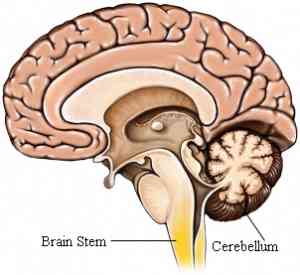

MedFriendly®


Post-Infectious Cerebellar Ataxia
Post-infectious cerebellar ataxia is a sudden loss of
muscle coordination caused by an infectious disease
that leads to damage of the cerebellum or connections
to it. The cerebellum is an area in the back, bottom part
of the brain that plays an important role in movement
and coordination. Areas connecting to the cerebellum
that can cause post-infectious ataxia are the pons,
cerebellar peduncles, red nucleus, and cerebellar
peduncles. The pons is a part of the brainstem that is
very important for sleep and arousal. The brainstem is
an area in the lower part of the brain that connects it
with the spinal cord.
FEATURED BOOK: Neuroanatomy through Clinical Cases
The cerebellar peduncles are bundles of nerve fibers that connect the brainstem with the
peduncles. The red nucleus is a large, well-defined, reddish-gray, elongated mass of cells
in the midbrain that receive massive amounts of input from the cerebellum. The midbrain
is the top part of the brainstem. A picture of the cerebellum and brainstem structures is
shown above.
HOW SOON AFTER CHICKEN POX DOES POST-INFECTIOUS ATAXIA OCCUR?
If post-infectious ataxia occurs after chicken pox (also known as varicella), this generally
occurs 7 to 14 days after chicken pox symptoms begins.
"Where Medical Information is Easy to Understand"™
WHAT ARE SIGNS OF POST-INFECTIOUS ATAXIA?
Common signs of post-infectious ataxia include sudden writhing
movements in the limbs (arms or legs), hypotonia, incoordination,
and action/intention tremors. Hypotonia is abnormally decreased
muscle tone (tension). This can present as poor maintenance of
posture, decreased resistance to slight pressure exerted on the
limbs, and delayed motor responses. Incoordination can present as
delays in initiating responses in limbs, errors in the force or range of
movement, and errors in the rate and regularity of movements. For
example, when the person tries to reach for something, he or she
may miss the target by a significant degree.
There may be an inability to walk without support. Incoordination can cause an impaired ability to perform
rapid, alternating movements - a problem known as dysdiadochokinesia. Action tremors (also known as
intention tremors) are shaking movements that become worse when performing voluntary movements.
If the cerebellar vermis is involved, an unstable stance, unsteady walking, and nystagmus (rhythmic
involuntary jerking or swinging movements of the eyes) can also result. The cerebellar vermis is a narrow,
worm shaped structure in between both sides of the cerebellum. The most severe disturbances in post-
infectious ataxia are caused by damage to the superior (top) cerebellar peduncles and the red nucleus.
See the first section for a description of the cerebellar peduncles and red nuclei.
HOW IS POST-INFECTIOUS ATAXIA DIAGNOSED?
Post-infectious ataxia is diagnosed by gathering a thorough medical history. One of the important things
that the physician will look for is if the person has been exposed to the varicella-zoster virus and if they
have symptoms consistent with chicken pox or shingles. The presence of a rash before the onset of
incoordinated movement is also helpful in diagnosing post-infectious ataxia.
HOW IS POST-INFECTIOUS ATAXIA TREATED?
Only the symptoms of post-infectious ataxia can be treated. This is usually done with physical therapy and
trying to make sure that patients do not hurt themselves because of incoordination. There is no
medication available that will reverse post-infectious ataxia. However, see the next section for good news
regarding prognosis.
WHAT IS THE PROGNOSIS FOR PEOPLE WITH POST-INFECTIOUS ATAXIA?
In most people, full recovery from post-infectious ataxia can be expected within a period of weeks to a
few months. However, there are occasional rare cases where the individual will be left with a permanent
movement disorder or behavioral problem. Swelling of the cerebellum is another rare complication.
WHAT IS THE ORIGIN OF THE TERM, POST-INFECTIOUS ATAXIA?
Post-infectious ataxia comes from the Latin word post meaning “after,” the Latin word “inficere” meaning
“to stain,” the Latin word "osus" meaning "full of," the Greek word “a” meaning “no,” and the Greek word
“taxis” meaning “order.” Put the words together and you get “after to stain full of no order.”















